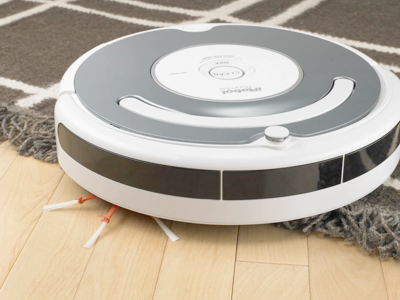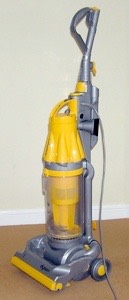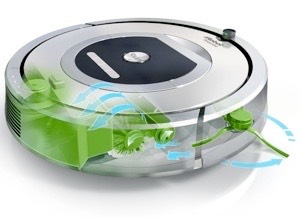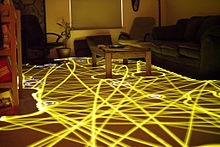What’s in a name?

The vacuum cleaner was developed in the early twentieth century; see wikipedia; I am attracted by HC Booth 1901, Walter Griffiths, 1905 both in Britain, and by two Americans, James Kirby in Cleveland in1906 and James Spangler in Ohio. Why, you ask? Who cares? Well, because we bought a Roomba, pictured above, and it is our habit to give our domestic assistants names.
[Actually, About inventors tells me I didn’t find the earliest inventor, referring me to John Thurman in St Louis in 1899 (Colin: Oct 3rd, no less). http://inventors.about.com/od/uvstartinventions/a/Vacuum-Cleaners.htm ]

Thus the washing machine is Dobby (JK Rowling) and Dhobi (as in Dhobi-wallah); the vacuum cleaner in Beijing is Sir James (Dyson, pictured in yellow).
Challenge 1: Name another house-elf.
I fancy calling the robot Arthur after Mr AC Clarke, but it seems I had been wrongly remembering Mr Spangler as being an Arthur too, plus enjoying the overlap with Dudley Moore in the 1981 film, because the Roomba does act a bit drunk. However, I find I had confused not only Mr Spangler’s first name but also confused Asimov and Clarke, Isaac and Arthur C.; It was Asimov who coined the three laws of Robotics in I, Robot.
Arthur Clarke wrote three laws on a slightly different topic, as is shown here:
Clarke's Three Laws from http://www-users.cs.york.ac.uk/susan/cyc/l/law.htm
1. When a distinguished but elderly scientist states that something is possible, he is almost certainly right. When he states that something is impossible, he is very probably wrong.
Asimov's Corollary to Clarke's Law: F&SF. Feb 1977
When, however, the lay public rallies round an idea that is denounced by distinguished but elderly scientists and supports that idea with great fervour and emotion -- the distinguished but elderly scientists are then, after all, probably right.
2. The only way to discover the limits of the possible is to go beyond them into the impossible.
3. Any sufficiently advanced technology is indistinguishable from magic.
Gehm's Corollary to Clarke's Third Law: -- Barry Gehm. Analog. 1991?
Any technology distinguishable from magic is insufficiently advanced.
Other versions of Law Three:
Any sufficiently advanced magic is indistinguishable from technology. Arlan Andrews, Sr., "Indian Summa", Analog, January 1989.
Any sufficiently advanced bug is indistinguishable from a feature. Rich Kulawiec
A side issue here is to read up on Laws; I recommend this page from Susan Stepney at York University, which I’ve quoted from on this page. I liked the rewrites of the laws of thermodynamics, but you might try those for yourself first, perhaps by writing a set for the opposite sex. The same book that Clarke’s three laws come from comments on the three stages that a revolutionary new idea will go through:
1. 'It's crazy --- don't waste my time.’
2. 'It's possible, but it's not worth doing.’
3. 'I always said it was a good idea.'
Schopenhauer got the same idea in the nineteenth century:
All truth passes through three stages: First, it is ridiculed; Second, it is violently opposed; and Third, it is accepted as self-evident.
Agassiz (like the motorbike?) said something similar at about the same time:
Every great scientific truth goes through three stages. First, people say it conflicts with the Bible. Next they say it had been discovered before. Lastly they say they always believed it.
Of course, in the US currently the Creationism / Darwinism debate issue shows that this order is not necessarily always correct.
Huxley (Thomas, not Aldous) had a go a little later:
It is the customary fate of new truths to begin as heresies and to end as superstitions.
Haldane [1963] lists the four stages of acceptance, which are rather nicely succinct; I’ve changed the font to something with a newer feel:
i) this is worthless nonsense; ii) this is an interesting, but perverse, point of view;
iii) this is true, but quite unimportant; iv) I always said so.
Challenge 2: Name other authors who have habitually used their middle initial in their ‘trade’ name, akin to Arthur C Clarke.
Ah, I get sidetracked so easily.

Naming the gadget: using John Thurman’s name suggests we could call it Uma after his distant relative; HC Booth was Hubert Cecil and father is a Hubert, so that’s tempting, but then the idea of him doing cleaning is as unlikely as Miss Thurman doing so, too. Mr Spangler turns out to be another James, so we’ll commemorate his efforts in combination with the excellent Dyson (importing one to China may have resulted in us having a first). The Roomba itself is from the iRobot Corporation; introduced in 2002 and popular in China, ours is a third generation model. Read about it here or here, where the latter is the company website. If you have a fast connection you might enjoy the brief video. Wikipedia shows this time-lapse photo of the path as it cleans. It is not especially quiet and I turn it on as going out (for breakfast on Saturday, typically) and it will

probably have tidied up and put itself back to recharge by the time I return. If it gets caught—a length of string, an escaped cable, a lost sock, and so on—then it turns off eventually and I rescue it on return and set it up again to work on Sunday. The flat is noticeably cleaner and I wasn’t thinking I’d been skimping in the sweeping up. It (not the machine, but good practice) helps to put chairs on the desk/table, to pick up the bins - and in the current flat I sometime close some doors so it finishes sooner. I cannot imagine any dog leaving this alone.
I’ll discuss this again with the boss; we’ve been calling it Mr Spangler, but Booth would be better; Arthur would be more fun and Isaac would be more accurate. Of course, there are some other Isaacs (no apostrophe there) to overlay meaning with: the bible book guy; the apple guy; the acronym for cleaning things - that’s appropriate; And of course, there’s Port Issac or Isaac back in Cornwall, whose streets wind much as the Robot’s route does.
Perhaps Isaac will win out.
Meanwhile, Dhobi the house elf says he’s finished the washing....
DJS 20140416
on which day Jessie married Phil
Isaac the bible guy: son of Abraham and Susan, father of Jacob & Esau, one of the more readable books in the bible.
Isaac the apple guy: Newton of course. He is so hated at school [wouldn’t you? Newton invented all the horrible Maths at senior school when he was about their age, or so they think]. The apple that hit his head weighed one newton of course and caused him to ponder on gravity.
Isaac the clean people: International Study of Asthma and Allergies in Childhood

Isaac the bike people: carbon frame specialists, www.isaac-cycle.com Isaac Photon 2014 shown
Arthur C Clarke, "Technology and the Future". Report on Planet Three. 1972
all three laws are cited there, though the first law was also in "Hazards of Prophecy: The Failure of Imagination". Profiles of the Future. 1962
The Three Laws of Robotics come from Isaac Asimov, Runaround (1942) and I,Robot (1950)
A robot may not harm a human being, or, through inaction, allow a human being to come to harm.
A robot must obey the orders given to it by human beings, except where such orders would conflict with the First Law.
A robot must protect its own existence, as long as such protection does not conflict with the First or Second Law."
Disagreement from Robert J Sawyer on http://www.sfwriter.com/rmasilaw.htm
Zeroth Law was added (Robots and Empire): A robot may not harm humanity, or, by inaction, allow humanity to come to harm. A fourth Law was added (1974): A robot must establish its identity as a robot in all cases. Harry Harrison added a different 4th Law in 1986; A robot must reproduce. As long as such reproduction does not interfere with the First or Second or Third Law. In 2004 Will Smith had fun and changed it to "When turning evil, display a red indicator light." A fifth law came from Kesarovski (date?) A robot must know it is a robot. A sixth Law appeared in 2013 (see the wikipedia article) All robots endowed with comparable human reason and conscience should act towards one another in a spirit of brotherhood. Of course we assume we agree what we mean by ‘robot’ and ‘human’. Possible short English essay: explore parallels between I, Robot and Citizen Kane.
Read this page from David Langford, http://www.ansible.co.uk/sfx/sfx146.html on the subject of Laws as expressed in science fiction.
Langford's Laws of Robotics,
1. A robot will not harm authorised Government personnel but will terminate intruders with extreme prejudice.
2. A robot will obey the orders of authorised personnel except where such orders conflict with the Third Law.
3. A robot will guard its own existence with lethal antipersonnel weaponry, because a robot is bloody expensive."
David and I were on the same staircase in Brasenose. We had not communicated between 1978 and 2014. David’s adjacent page to the one linked above points to Harry Potter, hero of David Leddick's 1999 novel The Sex Squad. Oh, dear me.
Note that David’s 1st rule distinguishes between intruder and authorised gov’t personnel. One assumes that non-authorised personnel are identified as intruders and that it is the authorisation that is the test applied. That doesn’t obviously allow any other classes of being. But it is neither, by implication. Um. Anything human not authorised will be harmed? Good job Rule 2 exists, provided the robot gives warning of imminent ‘harm’ so ‘cleared’ personnel can rescue the doubtful cases.
Susan in York added this: http://www-users.cs.york.ac.uk/susan/cyc/l/law.htm
Originally I, like many others, had this called "Benford's Corollary", and credited as "Gregory Benford. Foundation's Fear. 1997". Clark B. Wierda emailed me in Dec 2006 and pointed me to the following item on The MT Void, 23(19) 2004: Bill Higgins points out that "Any technology that does not appear magical is insufficiently advanced," given as Benford's Modified Clarke Law, is actually [Barry] Gehm's Corollary to Clarke's Third Law. Stan Schmidt published it in ANALOG, attributed to Barry, around 1991. According to Google, many sources appear to take it from Benford's 1997 novel FOUNDATION'S FEAR.
Professor Gehm adds, "Strictly speaking, my version was 'Any technology distinguishable from magic is insufficiently advanced,' but I think they're close enough that I'd be justified in claiming priority. My version seems to have traveled widely as various people (some of whom I know and some I don't) have used it as a .sig file (the cockleburrs of cyperspace)."
Challenge 1: Name some house Elves: Dobby (Malfoy house, then Hogwarts); Kreacher (Black household, then Hogwarts); Winky (Crouch household, then Hogwarts)
Challenge 2:
Middle initial folk:
Philip K Dick, Iain M Banks, Stephen M Baxter, Paul J McAuley, perhaps James T Kirk
Three name folk:
Arthur Conan Doyle, William Butler Yeats, Gabriel García Márquez, Jorge Luis Borges, Doris Kearns Goodwin, Charlotte Perkins Gilman, Hillary Rodham Clinton, Katherine Anne Porter, Ford Maddox Ford, John Stuart Mills, James Fenimore Cooper; David Foster Wallace. See Michael David Lukas, http://www.vqronline.org/authors/whats-middle-name. David Jay Brown,....
No Name folk: HG Wells, JK Rowling, etc
Oooh, I had a response!! Jen Reviews actually read what I’ve written. Her article is on the serious business of actually choosing a vacuum cleaner.